
In the increasingly competitive social environment of cultural tourism, the emergence of new media has accelerated the rapid transmission of news, and it is worth thinking about how to realize the sustainable development of culture and art with the help of modern information technology. This paper proposes the advantages of digitalization in the application of culture and art appreciation, using Kano model to analyze the data on the functional requirements of digital culture and art pavilions, to derive the ordering of the requirements, and then design the digital culture and art pavilions. Finally, the user functional requirements were explored in the form of a questionnaire survey, and after deriving the affiliation vector of the data, it was categorized into quality elements. The service attributes of the pavilion were determined by Better-Worse, and the ease of use of the pavilion was effectively measured. The results show that the digital pavilion’s “cultural characteristics” indicator has an affiliation vector of 0.2232, which is the focus of the design practice. Meanwhile, the average value of all the indicators except the sensory experience indicator is less than 2, which makes the pavilion easy to use. This study makes up for the shortcomings of art and culture development with modern information technology, and provides new ideas for the construction of digital sustainable development of culture and art.
ith the development of social economy, people gradually enter the Internet era, which has a more far-reaching impact on many production industries, in terms of film and television art appreciation, gradually formed a new appreciation mode, namely, the Internet + film and television art appreciation mode [1-4]. Media communication medium with the development of information technology, constantly updated, commonly used cell phones, the Internet, tablet computers, etc. have been integrated into people’s daily lives, which, to a certain extent, promote the development of art appreciation, so that it is constantly innovating, and gradually cater to the audience’s needs, harvest more audience favor.
With the continuous development of science and technology, all kinds of equipment, information dissemination carriers are also constantly changing, and its appreciation of the form gradually from the old media to the new media change [5-9]. The equipment used by the old media is all traditional electronic equipment, and this kind of communication has a certain conservative nature, and centralization is another characteristic of it. The equipment used by the new media is a new type of electronic device, such as tablet computers, smart phones, information networks, etc., which has strong flexibility and makes it more convenient for users to interact with external information, and their use time and geographical space have been greatly improved, and they can also be appropriately adjusted according to the specific characteristics of users, and have certain personalized capabilities [10-13]. Compared with the old media, the advantages of new media are more obvious, and its communication media has a strong mobility, which brings a greater impact on the old media art appreciation, and people prefer the new media appreciation form, so that the new media has gained further development. New media has strong innovation, and its development prospects are good, in the media art appreciation form, there is a trend to replace the old media [14-15]. In addition, mobile devices such as smart phones and tablet computers have been integrated into people’s lives, which has laid a good foundation for the development of new media, which is more acceptable and popular.
By examining the interrelationship between Copland’s pedagogy and music, literature [16] suggests that middlebrow culture poses a problem for high modernism, not only in its ability to mediate between elegance and vulgarity, modernism and popular culture, but also in the challenge it poses to the illusion of aesthetic immediacy and autonomy. The literature [17] discusses the concrete, emotional, spiritual, cultural, social, and political relationships that emerge in visual representation and environmental art. Respect for emotion, imagination and creative expression is called for, with a strong emphasis on images, objects and things that reflect life experiences. Literature [18] examines webcomics, the most prevalent and powerful form of digital series production in Korea in the 21st century. Webcomics have evolved by capitalizing on the various potentials offered by digital platforms, demonstrating the continued and intensified dependence of art on the platforms, and revealing some important aspects of the media ecosystem for art production in the digital age that are spreading and expanding into various artistic fields. Literature [19] deconstructs the relationship between media-induced tourism development and ’sustainability’, ’ecology’ and ’massification’. Media-induced ’popular culture’ is produced and consumed, and the conflict between them is increasing. This destabilizes “popular culture” as a ritualized behavior or field of experience. Literature [20] describes how the concept of “the medium” began to shape art criticism and curation in the United States. The “medium” emerged as a category of artistic organization and appreciation, as a dialectical counterpart to the medium, and as a response to its mass-produced form of cultural imperialism. As art becomes increasingly public, the medium becomes the public face of art. Literature [21] suggests further interdisciplinary dialog between media archaeology and cultural semiotics to understand the role of the archive in facilitating the process of cultural exchange and interconnectedness as well as the emergence of novelty, i.e., to understand the archive’s “creativity”. Literature [22] analyzes an iconic vision of a moving touchscreen based on sacred geographical inscriptions in profane spaces in the medieval Byzantine era. Thus, the presence of sacred, intangible images is perceived. An alternative is provided for understanding how digital and physical space work together to evoke what is essentially real.
In this paper, firstly, the characteristic attributes of culture and art are carefully sorted out in the perspective of thinking about sustainable development in the digital era. Taking user experience as the starting point and modern information technology as the basis, combined with Kano model, it discusses the demand design of digital culture and art exhibition hall. Next, the ordinal relationship analysis method is used to determine the weights of the service elements of the digital pavilion, and the index combination with the greatest similarity is selected to determine the final classification of the service quality elements. Finally, the digital culture and art pavilion was analyzed by user evaluation, which was validated by scientific and rigorous evaluation methods to detect whether it meets the design research in terms of usability, ease of use and user satisfaction.
Digitization means converting all kinds of cumbersome and complex data into numbers and data, which are then used as the basis for a set of binary codes. Images, text, sound, etc. can be carried out in this process, which is a basic digitization process. The technical methods of digitization are used to carry out design activities and make their design objects creative.
The digital form of culture and art, its according to the design object can be divided into four major categories:
Symbols carried by words, graphics, etc. Images, words, movements, sounds, etc. can be symbols and used as a tool for communication, so symbols were initially used as a token to represent other meanings. Secondly, symbols are the carriers to transmit information between two parties.
Objects created by human beings, the concept of artifacts is similar to product design products, such as engineering, architecture, or APP software, websites, etc. all belong to this category.
Actions and events, including actions, interactions and other behaviors that people carry out in order to achieve a certain purpose.
Systems and environments, including complex systems, environments, organizations, cultures, and processes. Every action of human beings is influenced by the system of the field in which they live, and this field does not only refer to the physical environment, but also includes other factors related to it.
In general, these four orders generally cover the goals of all cultural and artistic digital forms, and the four orders of cultural and artistic design are shown in Figure 1. When designing, the designer needs to discover and understand the problem from four different perspectives, and transform between the different perspectives. For a certain design object, the four domains are integrated and interact with each other. The design of the visual is dependent on the product in order to be presented, and the product determines the form of output of the visual symbols, and the two are interlocked.
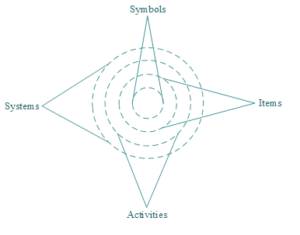
The overarching framework of the digital form of culture and art is shown in Figure 2. For a module in the system, the designer should expand to the horizontal domain, while in the overall module design, the designer needs to reflect the vertical design connotation.
The framework is an important tool for understanding the nature of design, a concept that provides designers with a holistic view of design and helps them make connections between digital knowledge and design skills. Therefore, all aspects of the design process need to be taken into account, including the design and output of symbols, the interaction of products with people, and the creation of human experience processes. This also provides an intuitive reference for digital design in culture and the arts.
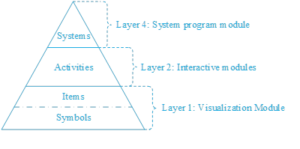
Digitization has such a wide prevalence in the appreciation of culture and art, which is determined by the characteristics of digitization itself. Digitization can display rich content, presented in a variety of forms and other characteristics, so that it can be well applied in all museums and cultural exhibition halls. The analysis of the advantages of the application of digitalization in the appreciation of culture and art is shown in Figure 3.
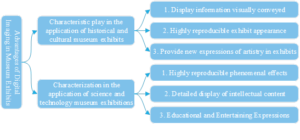
Visualization of display information: Digitization can visually express the content and information to be displayed according to the specific requirements of the culture and art museum. Through watching the image in the exhibition, visitors can intuitively receive the display information that the exhibition organizer expects to convey through the image.
High restoration of the appearance of exhibits: Digitization can achieve a high degree of restoration of the original appearance of cultural and artistic exhibits through digital technology, even for things that no longer exist, it can still provide a basis for the existing data related to the things constructed out of the items.
Providing new expressions of artistry in exhibits: In culture and art exhibition halls, many exhibits have high artistry. The intervention of digitization can enhance the artistic value of these exhibits and bring new aesthetic value to these exhibits through the form of digitization.
Expression of Education and Entertainment: Digitization can provide various display styles for scientific phenomena and technical principles in science and technology museums. It can be displayed by the way of plane two-dimensional animation, and it can also be presented by the way of digital three-dimensional animation, and it is also very common to present it by the way of digital movie.
Artists can use digital applications to make 3d modeling, scene rendering, 3d scanning and other technologies to convert ideas into a visual effect that has a real sense of reality uploaded to the online platform. This is the best embodiment of digital technology in public art development. The digital application not only brings more samples to public artists, but also gives artists some technical challenges. With the gradual maturity of Internet and digital technology, digital applications must also be a critical creative tool for public art creators.
Kano model is mainly a measure of user satisfaction, which establishes a relationship between the objective performance of products and services and user perception. And it divides them into five different types of quality attributes and expresses the degree and effect of each type of demand with a nonlinear relationship.Kano model is shown in Fig. 4, which divides CR into five different Kano categories according to the relationship between different types of quality characteristics and customer satisfaction:
Irrelevant quality (I): Whether this quality attribute is met or not, the digital design of cultural and artistic exhibition halls, user satisfaction will not be affected.
Reverse type quality (R): The realization of a quality attribute of digital culture and art pavilion leads to user dissatisfaction. When it is not realized, it enhances user satisfaction.
One-dimensional type of quality (O): The level of user satisfaction is positively correlated with the level of realization of this quality attribute, in a positive way. The higher the level of functional realization, the more satisfied the user is and vice versa.
Must-have type quality (M): The presence of certain quality attributes does not lead to user satisfaction. But if they are not present, they lead to user dissatisfaction.
Attractive quality (A): Once this quality attribute is realized, users will be satisfied. Also, the absence of this feature will not lead to user dissatisfaction.
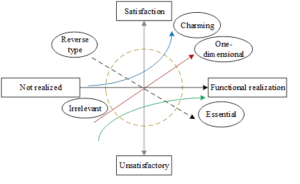
In this paper, the ordinal relationship analysis method (G1-method) is used to determine the weights of service elements \(w\), and the main steps are as follows:
Ranking the ordinal relationship between service elements: The expert scores the importance of the given service element \(A_{1} ,A_{2} ,\ldots ,A_{n-1} ,A_{n}\), which is recorded as \(A_{1} {}^{*} >A_{2} {}^{*} >A_{3} {}^{*} >\ldots A_{n-1} {}^{*} >A_{n} {}^{*}\), where, \(A_{i} {}^{*} >A_{j} {}^{*}\) means that the importance of service element \(i\) is above that of service element \(j\).
Assignment of the importance of service elements: The expert assigns a value of \(r_{k}\) to the size of the ordinal relationship formed by the service elements: \[\label{GrindEQ__1_} r_{i} =w_{i-1} /w_{i} ,\] where \(w_{i} ,w_{i-1} \tag{1}\) is the weight of service element \(i,i-1\), respectively. Weight \(w_{i}\) is to be derived by solving, while \(r_{k}\) is the expert’s scoring of the importance of neighboring service elements.
Calculate the weights of each service element. Specifically:
\[\label{GrindEQ__2_} \prod _{i=k}^{n}r_{i} =\frac{w_{k-1} }{w_{k} } \frac{w_{k} }{w_{k+1} } \ldots \frac{w_{n-2} }{w_{n-1} } \frac{w_{n-1} }{w_{n} } =\frac{w_{k-1} }{w_{n} } ,\;\;k\ge 2 . \tag{2}\] Summing \(k\) from 2 to \(n\) gives: \[\label{GrindEQ__3_} \sum _{k=2}^{n}\left(\prod _{i=k}^{n}r_{i} \right) =\sum _{k=2}^{n}\frac{w_{k-1} }{w_{n} } .\tag{3}\] Since the sum of weights is 1, it is obtained from Eqs. (3) and \(\sum _{k=1}^{n}w_{k} =1\): \[\begin{aligned} \label{GrindEQ__4_} 1+\sum _{k=2}^{n}\left(\prod _{i=k}^{n}r_{i} \right) = 1+\sum _{k=2}^{n}\frac{w_{k-1} }{w_{n} } =\frac{w_{n} }{w_{n} } +\sum _{k=2}^{n}\frac{w_{k-1} }{w_{n} }=\frac{1}{w_{n} } \sum _{k=1}^{n}w_{k} =\frac{1}{w_{n} }. \end{aligned} \tag{4}\] From (4), it can be seen that as long as the weight \(w_{n}\) of the last service element is obtained, the weights of the remaining service elements can be deduced through (1). After deforming Eq. (4), it is calculated through the following formula: \[\label{GrindEQ__5_} w_{n} =\left[1+\sum _{k=2}^{n}\left(\prod _{i=k}^{n}r_{i} \right) \right]^{-1} . \tag{5}\] The weights of the remaining service element \(A_{i}^{*} (i=1,2,\ldots ,n-1)\) can be introduced step by step by the following equation: \[\label{GrindEQ__6_} w_{k-1} =r_{k} w_{k} . \tag{6}\]
The satisfaction evaluation ratings of the service elements collected through the improved Kano questionnaire were converted into ordinary fuzzy numbers by obtaining a control table as shown in Table 1. By normalizing the ordinary fuzzy numbers, the conventional method is the linear transformation method for: \[\begin{aligned} \label{GrindEQ__7_} x_{ij} =\left(x_{ij}^{L} ,x_{ij}^{MI} ,x_{ij}^{MU} ,x_{ij}^{U} \right)=\left(\frac{r_{ij}^{L} }{r_{j}^{+U} } ,\frac{r_{ij}^{ML} }{r_{j}^{+U} } ,\frac{r_{ij}^{MU} }{r_{j}^{+U} } ,\frac{r_{i}^{U} }{r_{j}^{+U} } \right), \end{aligned} \tag{7}\] for \((1\le i\le m,1\le j\le n),\) where \(r_{j}^{+U} ={\mathop{\max }\limits_{i}} \left(r_{ij}^{U} \right)\). Calculated based on (7), the transformed normalized trapezoidal fuzzy number shown in the table can be obtained. The normalized fuzzy index in the usual sense can be obtained by the transformation calculation of the ordinary fuzzy number.
| Satisfaction evaluation | Trapezoidal fuzzy number | Standardization of trapezoidal fuzzy Numbers |
| Very hate | (0,0,0,2) | (0,0,0,0.065; 1.0) |
| More hate | (0,2,4,6) | (0,0.065,0.135,0.2; 1.0) |
| Hate | (4,6,8,10) | (0.135,0.2,0.265,0.335; 1.0) |
| Can tolerate | (8,10,12,14) | (0.265,0.335,0.4,0.465; 1.0) |
| Indifference | (12,14,16,18) | (0.4,0.465,0.535,0.6; 1.0) |
| Take for granted | (16,18,20,22) | (0.535,0.6,0.665,0.735; 1.0) |
| Satisfied | (20,22,24,26) | (0.665,0.735,0.8,0.865; 1.0) |
| Relatively satisfied | (24,26,28,30) | (0.8,0.865,0.935,1.0; 1.0) |
| Very satisfied with | (28,30,30,30) | (0.935,1.0,1.0,1.0; 1.0) |
Against this table the fuzzy language of the respondents’ satisfaction is transformed into a trapezoidal fuzzy number, which is the rating value. The transformed satisfaction of each element is obtained by the following formula: \[\begin{aligned} \label{GrindEQ__8_} A_{j} =\sum _{i=1}^{n}{A_{j}^{i} \mathord{\left/ {\vphantom {A_{j}^{i} n}} \right. } n} ={\left(\sum _{i=1}^{n}a_{j1}^{i} ,\sum _{i=1}^{n}a_{j2}^{i} ,\sum _{i=1}^{n}a_{j3}^{i} ,\sum _{i=1}^{n}a_{j4}^{i} ;n*w_{j} \right)\mathord{\left/ {\vphantom {\left(\sum _{i=1}^{n}a_{j1}^{i} ,\sum _{i=1}^{n}a_{j2}^{i} ,\sum _{i=1}^{n}a_{j3}^{i} ,\sum _{i=1}^{n}a_{j4}^{i} ;n*w_{j} \right) n}} \right. } n} , \end{aligned}\tag{8}\] where, \(A_{j}\) denotes the trapezoidal fuzzy value of the \(j\)nd element satisfaction, \(n\) denotes the number of questionnaires, and \(j\) denotes the number of service elements. The similarity between the transformed elemental satisfaction \(A_{j}\) and the canonical trapezoidal fuzzy number B for each satisfaction evaluation level is calculated as: \[\begin{aligned} \label{GrindEQ__9_} S\left(A_{j} ,B\right)=\left(1-\frac{\sum _{i=1}^{4}\left|a_{i} -b_{i} \right| }{4} \right) \times \frac{\min \left(P\left(A_{j} \right),P(B)\right)+\min \left(w_{A_{j} } ,w_{B} \right)}{\max \left(P\left(A_{j} \right),P(B)\right)+\max \left(w_{A_{j} } ,w_{B} \right)} , \end{aligned} \tag{9}\] where \(P\left(A_{j} \right)\) and \(P(B)\) are respectively: \[\begin{aligned} \label{GrindEQ__10_} P\left(A_{j} \right)=\sqrt{\left(a_{1} -a_{2} \right)^{2} +w_{A_{j} }^{2} } +\sqrt{\left(a_{3} -a_{4} \right)^{2} +w_{A_{j} }^{2} } +\left(a_{3} -a_{2} \right)+\left(a_{4} -a_{1} \right), \end{aligned} \tag{10}\] \[\begin{aligned} \label{GrindEQ__11_} P(B)= \sqrt{\left(b_{1} -b_{2} \right)^{2} +w_{B}^{2} } +\sqrt{\left(b_{3} -b_{4} \right)^{2} +w_{B}^{2} } +\left(b_{3} -b_{2} \right)+\left(b_{4} -b_{1} \right) . \end{aligned} \tag{11}\] And the combination of indices with the greatest similarity is selected to determine the final classification of service quality elements.
As the skeleton of the product, the information architecture not only inherits the demand research of the strategy layer and scope layer, but also guides the design of the framework layer. The information architecture of Digital Culture and Art Pavilion is shown in Figure 5, which is divided into four modules: home page, thematic exhibitions, community and personal center, with clear and reasonable architectural layers and detailed contents, and then subdivided by each module to form the whole digital culture and art pavilion content.
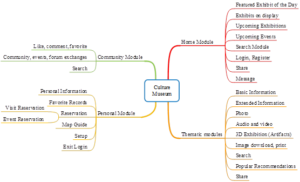
The user process can guarantee that the information architecture is logically clear and structurally complete. There are four main steps in the user process, discovery, understanding, operation and follow-up, and through the use of scenario thinking, it is possible to quickly understand these four steps. The main process of digital culture and art exhibition hall users is shown in Figure 6, in which the elements of the user process are mainly composed of pages, actions and conditions. The beginning and the end are the starting point and the end point of the process, the starting point can be more than one, but the end is only one, that is, there can be multiple ways to reach the end point. The page is usually represented by a rectangle, and the diamond is the shape of the user’s judgment when making decisions. The user flow can determine the low-fidelity diagram of the product, which is the skeleton of the function.
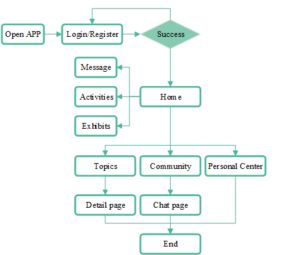
The user flow of Digital Culture and Art Pavilion mainly shows the user’s flow from login to leaving, the user jumps to the login/registration page by opening the APP, and jumps to the home page if the login or registration is successful; the home page can jump to the interface of news, activities, exhibit details page, etc.; the home page jumps to the featured, community, and personal center pages, and there is also a sub-division of each page to the detailed page, and the last is to leave the APP. and end the process.
In the final stage of product development, it is critical and necessary to conduct user experience testing. User experience testing can not only determine the needs of the target group, but also play a guiding role in the early stage of development. It can also confirm whether the product meets the design requirements by obtaining operational data and user feedback in the later stages of development. Errors can be identified in time and modified to serve further optimization during iterative development. Therefore, this paper sets up a follow-up user evaluation analysis of the digital culture and art pavilion, which is validated through scientific and rigorous evaluation methods to detect whether it meets the original intention of the design study in terms of usability, ease of use and user satisfaction.
The basic purpose of the digital art exhibition is to serve the public and understand the requirements and expectations of the audience of the digital cultural exhibition museum, which is the prerequisite for the success of the digital cultural exhibition museum. Through the questionnaire, the requirements analysis of different ages and the level of education was analyzed, so that the aesthetic perception and communication experience requirements of different audience groups were learned, and the audience demand was satisfied in the digital cultural exhibition hall.
The questionnaire is set up mainly for the demand of the digital cultural exhibition hall, which is directed by the audience, and the section of the topic is presented in a popular language. The purpose of the audience experience questionnaire is to solve the needs of the audience to build up the digital cultural exhibition hall that meets the needs of the audience. The questionnaire structure is composed of single choice, multiple-choice and subjective.
Based on the previous Kano model for the design of the needs of digital culture and art exhibition halls, a questionnaire was designed. In the questionnaire survey process, a total of 108 valid questionnaires were recovered, and the recovered questionnaires were counted for basic information, and the results obtained are shown in Table 2. It can be seen that the proportion of men is 54.63%, the proportion of women is 45.37%, and the proportion of men and women is relatively balanced. The survey sample is mainly 25 years old and below, of which 25 years old and below account for half. The educational background is dominated by bachelor’s degree, accounting for 57.41%.
| Item | N | Percentage (%) | |
| Gender | Male | 59 | 54.63 |
| Female | 49 | 45.37 | |
| Age | Age 25 and under | 54 | 50.00 |
| 26-35 years old | 25 | 23.15 | |
| 36-45 years old | 24 | 22.22 | |
| 45 years of age or older | 5 | 4.63 | |
| Educational background | High school/technical secondary school and the following | 4 | 3.70 |
| Junior college | 34 | 31.48 | |
| Undergraduate course | 62 | 57.41 | |
| Master degree or above | 8 | 7.41 | |
In this paper, the reliability and validity of the questionnaire was analyzed by SPSS software and the value of reliability coefficient was obtained as 0.946, which is greater than 0.9. The value of KMO obtained was 0.914, which is greater than 0.8, and it passed the Bartlett’s test (p-value less than 0.05). It indicates that the quality of reliability and validity of the research data is high and can be analyzed in the next step.
The reliability and validity of the questionnaire data is completed to confirm the validity of the questionnaire. Following the results of the questionnaire, statistics on the attribute classification of each user’s demand items for digital culture and art pavilions, Better-Worse coefficient to calculate the affiliation vector, analyze and determine the functional attributes.Kano model analysis control is shown in Table 3, where the horizontal coordinate is the inverse problem, the vertical coordinate is the positive problem, all using a 5-level scoring system.
| Demand item | Inverse problem | |||||
| Dislike (1 point) | Can tolerate(2 point) | It doesn’t matter(3 point) | That’s right (4 point) | Like (5 point) | ||
| Forward problem | Dislike (1 point) | Q | R | R | R | R |
| Can tolerate (2 point) | M | I | I | I | R | |
| It doesn’t matter(3 point) | M | I | I | I | R | |
| That’s right (4 point) | M | I | I | I | R | |
| Like (5 point) | O | A | A | A | Q | |
The results of Kano’s questionnaire are shown in Table 4, which shows that out of the 21 demand items, there are three one-dimensional qualities (O), nine irrelevant qualities (I), and nine must-have qualities (M).
| Serial number | Demand item | Sorting item | Ownership | |||||
| R | I | M | O | Q | A | |||
| 1 | Culture and art exhibition hall overview | 3 | 35 | 26 | 27 | 4 | 13 | I |
| 2 | Ticket service | 8 | 14 | 14 | 55 | 9 | 8 | O |
| 3 | Tour instructions | 4 | 27 | 57 | 9 | 7 | 4 | M |
| 4 | Visit reservation | 9 | 30 | 23 | 26 | 6 | 14 | I |
| 5 | Bus routes | 6 | 56 | 15 | 10 | 10 | 11 | I |
| 6 | Exhibition information | 5 | 24 | 50 | 15 | 6 | 8 | M |
| 7 | Pavilion news | 15 | 18 | 64 | 5 | 4 | 2 | M |
| 8 | Multimedia introduction to collections | 12 | 52 | 24 | 6 | 8 | 6 | I |
| 9 | Content retrieval | 3 | 37 | 44 | 8 | 9 | 7 | M |
| 10 | Visit the route | 7 | 5 | 60 | 25 | 8 | 3 | M |
| 11 | Explanation service | 7 | 40 | 29 | 21 | 9 | 2 | I |
| 12 | Virtual tour | 12 | 60 | 11 | 16 | 3 | 6 | I |
| 13 | Multilingualism | 11 | 25 | 9 | 48 | 7 | 8 | O |
| 14 | Cultural and creative shop | 9 | 42 | 25 | 25 | 6 | 1 | I |
| 15 | Tour feedback | 15 | 29 | 32 | 17 | 9 | 6 | M |
| 16 | Personal center | 5 | 29 | 32 | 29 | 9 | 4 | M |
| 17 | Collect and share content | 4 | 4 | 54 | 27 | 3 | 16 | M |
| 18 | Network community | 14 | 64 | 0 | 24 | 6 | 0 | I |
| 19 | Download collection images | 11 | 20 | 54 | 5 | 8 | 10 | M |
| 20 | Website interface design is beautiful | 5 | 47 | 24 | 20 | 3 | 9 | I |
| 21 | The interface contains cultural | 5 | 30 | 26 | 35 | 5 | 7 | O |
The traditional Kano model simply processes data based on the evaluation table, and the category with the highest proportion of demand items is the demand type of the item, and some of the data is not used, which cannot really find the user’s demand points, which is not conducive to discovering potential needs. This paper uses the Better-Worse index analysis method to analyze the relationship between various indicators and user satisfaction, this coefficient contains the two judgment indices of Better and Worse, Better indicates the degree to which the demand item affects user satisfaction, in general, greater than 0, the larger the value, the more significant the effect of customer satisfaction improvement. Worse indicates the degree to which the demand item affects user dissatisfaction, which is generally negative, and the smaller the value, the more obvious the effect of reducing customer satisfaction.
The five demand dimensions are further categorized for their demand characteristics, excluding nine irrelevant qualities (I), retaining three one-dimensional qualities (O) and eight must-have qualities (M). The final weights and ranking results are shown in Table 5. It can be seen that, except for the visual requirements of “beautiful website interface design” and “interface with cultural characteristics”, the other requirements are all functional requirements. Among them, the 21st item “the interface contains cultural characteristics” has an affiliation vector of 0.2232, which is the focus of the next design practice, and the importance of the requirement items will be used as a guideline for the design of the digital culture and art pavilion.
| Serial number Demand item | Better-Worse | Weight | Sort | Ownership | ||
| Better | Worse | |||||
| 2 | Ticket service | 0.2703 | -0.3167 | 2.356% | 11 | O |
| 3 | Tour instructions | 0.2196 | -0.2680 | 7.189% | 7 | M |
| 6 | Exhibition information | 0.3192 | -0.2475 | 5.252% | 9 | M |
| 7 | Pavilion news | 0.2234 | -0.2145 | 9.133% | 5 | M |
| 9 | Content retrieval | 0.3048 | -0.3047 | 10.807% | 3 | M |
| 10 | Visit the route | 0.2647 | -0.1540 | 9.581% | 4 | M |
| 13 | Multilingualism | 0.3238 | -0.2591 | 7.334% | 6 | O |
| 15 | Tour feedback | 0.1775 | -0.1375 | 2.205% | 12 | M |
| 16 | Personal center | 0.2554 | -0.3215 | 5.385% | 8 | M |
| 17 | Collect and share content | 0.2482 | -0.3151 | 4.907% | 10 | M |
| 19 | Download collection images | 0.2432 | -0.3787 | 13.527% | 2 | M |
| 21 | The interface contains cultural | 0.1575 | -0.2186 | 22.320% | 1 | O |
| Basic parameter | Usability parameters | ||||||
| Serial number | Total points | Mean value | Sort | Usability type | Total points | Mean value | Sort |
| 1 | 27 | 1.80 | 8 | Degree of fluency | 25 | 1.67 | 3 |
| 2 | 6 | 0.40 | 15 | ||||
| 3 | 31 | 2.07 | 5 | ||||
| 4 | 30 | 2.00 | 6 | Sensory experience | 84 | 5.60 | 1 |
| 5 | 7 | 0.47 | 14 | ||||
| 6 | 36 | 2.40 | 4 | ||||
| 7 | 21 | 1.40 | 10 | Learnability | 20 | 1.33 | 4 |
| 8 | 29 | 1.93 | 7 | ||||
| 9 | 40 | 2.67 | 1 | Efficiency | 15 | 1.00 | 6 |
| 10 | 10 | 0.67 | 13 | ||||
| 11 | 18 | 1.20 | 12 | Error rate | 35 | 2.33 | 2 |
| 12 | 19 | 1.27 | 11 | ||||
| 13 | 38 | 2.53 | 3 | Fault-tolerant | 8 | 0.53 | 7 |
| 14 | 22 | 1.47 | 9 | Subjective satisfaction | 16 | 1.07 | 5 |
| 15 | 39 | 2.60 | 2 | ||||
Ease of use is an important parameter of digital culture and art exhibition hall, which refers to whether the hall is easy to use and learn for users, whether it is easy to memorize and so on, in short, it can be attributed to the overall feeling of satisfaction of users in the process of using. Ease of use is an important factor in usability, any product should not only ensure usability, but also have a friendly interaction design and sufficient product ease of use. Therefore, on the basis of completing the usability test of the product, the original subjects were asked to judge the experience of using the Digital Culture and Art Pavilion, which led to the conclusion of the evaluation of the design in terms of ease of use.
Firstly, the ratings of 108 subjects in the original data table were summed and summarized respectively and the mean value was calculated, and the score values were sorted. And then take the ease of use evaluation index as the benchmark, sum the scores of all the questions of each evaluation index and calculate the average value, and comprehensively rank the seven ease of use indicators to get the mean value of the original data, as well as the sorting results as shown in Table 6. Firstly, the ease of use indicators are analyzed, except for the sensory experience indicator, the average value of other indicators is less than 2, which belongs to the better ease of use items. Among them, the fault tolerance score is only 0.53, which indicates that the system has a good error recovery function, while the mean value of subjective satisfaction is only 1.07, which indicates that the users are satisfied with the system. From the data, we find that the mean value of sensory experience is high, 5.60, which is a problem that needs proper attention, and we need to analyze each problem in order to understand the specific reasons for it.
Overall, the overall ease of use of the digital culture and art pavilion is good, with the scores of all indicators except sensory experience below 2. And it is worth noting that in the underperforming sensory experience, the visual effect and auditory effect scores are small, indicating that the audiovisual effect of the pavilion’s culture and art is very good. The reason why the overall sensory experience is poor is mainly due to the vertigo feeling of the digital display, which leads to a high problem score and pulls up the overall index score. The sense of vertigo is a common problem of all digital products, due to the specificity of the experience environment of digital products, the user must wear a specific device to experience, subject to the current stage of the experience of the technology and quality of hardware equipment can not do to eliminate the sense of vertigo. As far as the digital culture and art exhibition hall itself is concerned, the ease of use has reached the set target in all aspects of the indicators.
Based on modern information technology and Kano model, this paper proposes the design concept of a cultural and art pavilion based on somatosensory interaction. The usability, ease of use and user satisfaction of this pavilion are effectively measured in the user evaluation stage. The following research results are derived throughout the process:
Among the 21 requirements for the design of culture and art pavilions, there are three one-dimensional qualities (O), nine irrelevant qualities (I), and nine essential qualities (M). Among them, the largest affiliation vector of requirement items is “cultural characteristics” (0.2232), which is the focus of digital pavilion design practice.
The digital culture and art pavilion has a high degree of usability and ease of use, compared with the traditional culture and art appreciation form, the digital form can give people an unprecedented novel experience in the visual and auditory aspects, and obviously improve the user’s interactive participation, greatly increasing the user’s interest in culture and art.
In summary, the new form of culture and art media appreciation proposed in this paper is recognized by users in the evaluation. However, there is still room for improvement in the interaction mechanism and hardware equipment of the digital exhibition hall, which is generally in line with the target setting.